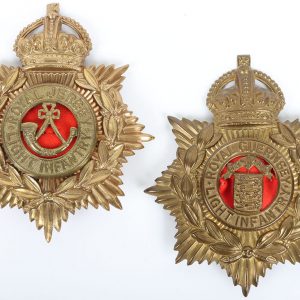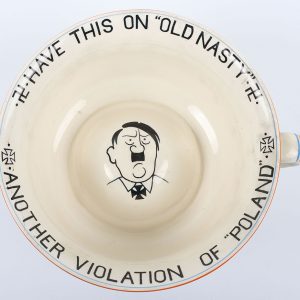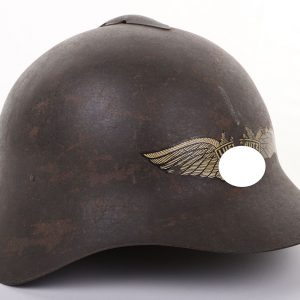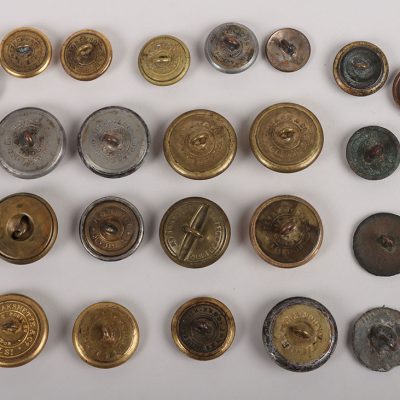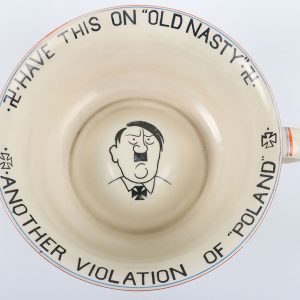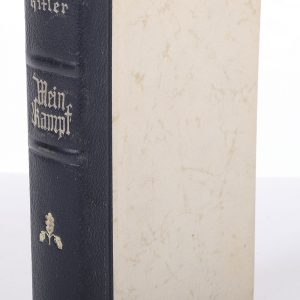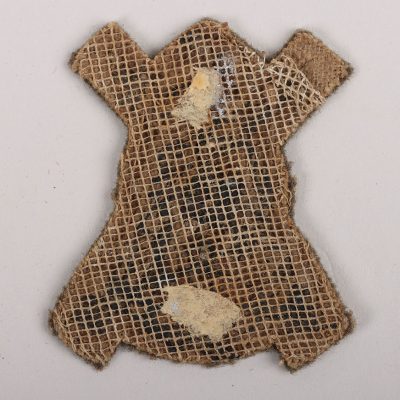Цены, указанные на сайте, могут быть изменены.
Для уточнения актуальных цен свяжитесь с нами или воспользуйтесь формой обратной связи.
Отображение 881–896 из 3607
Фильтры-
#127 – RUSSIAM M-36 HELMET REISSUED TO THE GERMAN LUFTSCHUTZ (Лот: 5458)
Ставки принимаются через менеджераRUSSIAM M-36 HELMET REISSUED TO THE GERMAN LUFTSCHUTZ, a rare lst pattern liner w/ corrugated spacers & 1 pattern chin-strap, retains 80% of its dark green paint & 80% of its ‘LUFTSHUTZ’ decal w/ has a gold hue, has a brown cloth crown lining & a gray oilcloth lining band, w/ partial chin-strap, overall VG.
-
#127 – WW2 German Kriegsmarine Officers Dress Dagger by Carl Eickhorn, Solingen (Лот: 7316)
Ставки принимаются через менеджераWW2 German Kriegsmarine Officers Dress Dagger by Carl Eickhorn, Solingen, standard example with white celluloid grip, brass eagle pommel top. Cross guard with press button release catch. Housed in standard pattern brass scabbard. Blade etched with foliage and anchors. Makers trademark to the reverse. Blade missing the spring release catch. Blade 24 ½ cms, overall 41 ½ cms.
-
#127 – An impressive Second World War Coastal Forces Distinguished Service Medal Group of Six to a Petty Officer who was Mentioned in Despatches for Crete and was Later Awarded a D.S.M. and Another Mentioned in Dispatches for his Service in Motor Torpedo Boats off the Dutch and Belgian Coasts in 1944 (Лот: 8719)
Ставки принимаются через менеджераAn impressive Second World War Coastal Forces Distinguished Service Medal Group of Six to a Petty Officer who was Mentioned in Despatches for Crete and was Later Awarded a D.S.M. and Another Mentioned in Dispatches for his Service in Motor Torpedo Boats off the Dutch and Belgian Coasts in 1944, Distinguished Service medal, GVI 1st type, ‘JX. 144769 E.J. WHITE R.N. T/PO’, Naval General Service medal with clasp Palestine 1936-1939, ‘JX. 144769 E. WHITE, A.B., R.N.’, 1939-45 Star medal, Atlantic Star medal with clasp France & Germany, Africa Star medal and War medal 1939-45. Group mounted for wearing with push stud fitting on the reverse. Sold with a quantity of original documentation and related artefacts. x Ron Penhall collection.istinguished Service medal – London Gazette – 13th July 1943 – For skill and daring in many successful attacks on enemy forces, made in enemy coastal waters, while serving in light coastal craft. Temporary Petty Officer Edwin John White, D/JX.I44769.ention in Despatches – London Gazette 11th November 1941 – The KING has been graciously pleased to approve the following Rewards for gallantry and distinguished services in operations in Greek waters: Leading Seaman Edwin John White, D/JX.I44769, H.M.S. Isis.ention in Despatches – London Gazette 2nd January 1945 – For courage, leadership and skill while serving in Light Coastal Craft in attacks on enemy shipping: Petty Officer Edwin John White, D.S.M., D/JX. 144769 (Aberdare).dwin John White was born at Aberdare, South Wales and entered the Royal Navy as a boy rating in 1935. His first wartime commission was aboard the destroyer H.M.S. Isis in Norway in 1940. She sailed for the Mediterranean where she quickly saw action in the evacuations of Greece and Crete – in the period 26-30 April 1941 alone, Isis embarked 1400 troops, around 250 of them from Kalamata ‘although the enemy were then in possession ashore’. White was mentioned in despatches.n his return home from the Mediterranean, he joined the 21st M.T.B. Flotilla under Commander Peter Dickens, R.N., being appointed Coxswain to another distinguished Coastal Force’s officer, Lieutenant G. J. ‘Mac’ MacDonald (D.S.O., D.S.C.**), R.N.Z.N.V.R. As a result, he quickly found himself back under enemy fire, not least on the night of 7-8 August 1942, in what became known as the ‘Second Battle of Barfleur’. Such was the point-blank nature of the firefight enacted off Barfleur that night, that Dickens was moved to describe his own Number One’s survival as ‘one of those miracles of war that one comes to accept as normal – and that would be fine if they did not work the other way just as readily’. The officer in question, Lieutenant R. G. ‘Bob’ Gaunt, S.A.N.F., was twice lifted off his feet, once by a ‘brute of a 37mm. shell’ and again when his M.T.B’s petrol tank ‘blew its top’ – nonetheless, though shocked and wounded, he displayed great gallantry in fire-fighting duties..T.B. 241, with White at the helm and MacDonald in command, was one of two boats from the 21st M.T.B. Flotilla to accompany Dickens’ command, M.T.B. 237 that night, the small force slipping out of the Coastal Forces’ base Hornet at Gosport with the intention of finding business on an enemy convoy route off Cape Barfleur. A Le Havre-bound force of six enemy auxiliary vessels – four of them heavily-armed Minensuchboote (minesweepers) – emerged through the gloom after a hour’s wait. Dickens gave the order to attack, the three M.T.Bs crash-starting their main engines and approaching the enemy convoy through a curtain of fire at full speed, closing the range to a matter of yards. Dickens’ boat, 237, was quickly hit by 20mm. fire, but worse was to follow when a 37mm. shell smashed into the wheelhouse, where Gaunt and a fellow officer were trying to navigate – incredibly, having been blown off their feet by the force of the explosion, both officers were seen to emerge from the impressive hole left by the shell. As for White in 241, but for the handy gunnery of an ancient mariner his fate may have been similar: ‘Mac took 241 away to the northwest at full speed to probe the enemy at another point, and almost immediately found himself crossing the RA 2s bows [an enemy motor minesweeper] at an acute angle. The encounter was a surprise to both though that did not prevent either from engaging; and since RA 2 was equipped with six guns of up to 37mm. calibre against 241’s twin machine-guns, and the range was 70 yards and closing, logic would suggest that the latter should have been taken apart … [but] … she was well within the scope of Able Seaman Gunner ‘Ginger’ Harry in the 0.5-inch turret. He was an old man of forty-seven who sat hunched between the barrels, clenching between his no doubt toothless gums an old clay pipe; the bowl was downwards and it was unlit, not because he scorned to smoke it but because Edwin White the Coxswain, Welsh and a regular Petty Officer, made very sure he did not, perched as he was on top of the petrol tank. Harry let fly, rock steady and impervious to the enemy’s tracer, which is the only way to shoot straight when someone is shooting at you. He hit RA 2 ten times, wounded one man badly and one slightly, caused her gunners’ aim to falter, and perhaps was the reason for her ceasing fire altogether. At 40 knots 241 was soon out of danger, perhaps even before her crew fully realized they were in it. White told me, ‘It was very enjoyable that night when old Harry got going with his point fives.’ When, at length, the severely damaged 237 ‘blew her top’, it fell to White to bring 241 alongside her blazing hull, the survivors jumping over to safety, and the exhausted party reached Gosport in the early morning hours. Here, having found a sentry asleep on duty and an equally unconscious Officer of the Day, Dickens stormed in to his shore Captain’s sleeping quarters to deliver a sharp account of the evening’s proceedings and to inform him – his senior standing dazed in his pyjamas – that ‘not a soul in this benighted dump gives a damn.’onsidering that ‘The Second Battle of Barfleur’ was pretty typical of the actions fought by the men of the 21st M.T.B. Flotilla over the next two or three years, or at least typical in the sense of the ferocity of such encounters, it seems extraordinary that White was wounded on only one occasion. Indeed it is clear from Dickens’ classic account of the Flotilla’s work up until his handing over command in mid-1943 – Night Action – that M.T.B. 241, with White at the helm, went on to fight in a host of similar point-blank firefights – far too many, in fact, to describe for the purposes of this exercise. But by way of summary, it is worth noting that the author dedicates whole sections of his book to clashes off Holland on the 19 January (‘Hook’), 18 April (‘Bullfight’), 21 April (‘Bottom’), 29 April (‘Ijmuiden’), 14 May (‘Minesweepers’) and 25 July (‘Noord-wijk’) 1943.f the action off Ijmuiden on the night of 29 April 1943, Dickens states: ‘The [enemy’s] 14th V.P. Flotilla suspected nothing until 0335 but then their reaction was very fast; 234 in the centre, and slightly ahead of the other two boats, was first to be seen and a concentrated fire was opened at 600 yards which I should call murderous except that no one was killed or even hurt. My sight was lined up on the third ship, speed setting five knots course south, but as soon as the shooting started the point of aim was obscured; I loosed off at a gunflash, but who could tell whether my hand shook a little? I could, and it did; furthermore the German Senior Officer in VP 1401 took the bold emergency action of turning his group towards us, combing the tracks. So I missed, but Mac was directly helped by the enemy’s concern with me and had a clear run in for a few more vital seconds. White told him, ‘If we don’t hit this time … ‘, and indeed it just had to be. Mac pressed in ever closer, the repeater sight did everything expected of it and White held the boat steady until the torpedoes were well into the water. Then 241 was seen, fiercely engaged by her own target at close range, and White finished his sentence, ‘ … We’ve had it.’ She was only hit twice, one in the turret which slightly wounded Harry the Gunner but his life was saved by the bullet-proof plating, and then the enemy’s guns were carried below the surface. The enemy’s turn had helped 241 who had to fire from the quarter, because it meant that his beam was presented to the torpedoes when they arrived; one of them hit, and the explosion was so massive that spray fell on to 241 as she disengaged close astern.’hite’s D.S.M. – and MacDonald’s second D.S.C. – were awarded in respect of the action of 14 May 1943, when four M.T.Bs of the 21st Flotilla met the largest and most powerful force they had ever encountered, namely 12 fleet minesweepers and nine R-boats. On that occasion Dickens opted for a two-pronged attack, White steering 241 in the second of these amidst a torrent of enemy fire – and although 241’s torpedo appears to have missed the enemy minesweeper M 8, her consort found the mark. It was equally satisfying to see the surviving minesweepers then engage the R-boats as they closed to offer assistance to the stricken M 8. Inevitably, perhaps, 241 finally fell to the enemy’s guns, in an action fought off the Dutch coast on the night of 30 March 1944, when five M.T.Bs took on a convoy of six merchantmen with an 18-strong escort, four M-class minesweepers, with a 6-strong escort, astern of this force, and eight R-boats ahead of it – horrendous odds indeed, especially since the enemy sighted the M.T.Bs before they could fully develop their attack. The latter’s response was swift and accurate, the minesweepers and R-boats putting down a curtain of heavy fire, and before White could properly disengage to the north-west, a 105mm. shell struck 241 a mortal blow underwater, in the engine room. Their boat completely disabled, MacDonald, White and the remainder of the crew were taken off by M.T.B. 224, and the crippled 241 taken in tow. About eight hours later, however, she rolled over and sank.hite’s final accolade, his second ‘mention’, was acquired for the above quoted action in the Nore area on the night of 14-15 September 1944, during which one enemy vessel was sunk – this time, however, he was behind the wheel of MacDonald’s new command, M.T.B. 234.he recommendation for this award being ‘For extreme disregard for danger and outstanding coolness in the execution of his duty as Coxswain in M.T.B. 234 while in action against a heavily defended escorted enemy convoy on the night of 14-15 September 1944. During the three attacks in each of which the boat came under fire, Petty Officer White stood firmly at the wheel carrying out the orders given him with precision, alacrity and initiative which inspired all with confidence and pride and set an example suitably fitting the high traditions of the Service. This man is one in whom Britain may be proud for no head is held so high as his in action.’hite ended his War as Coxswain of the escort carrier Atheling and was pensioned ashore in 1949.
-
#127 – 1 HEER PHOTO POSTCARD SHOWING A MAN WEARING PANZER WRAPPER & AN OFF. M-42 CAP (Лот: 7480)
Аукцион завершенМинимальная цена продажи 100 $ не достигнута1 HEER PHOTO POSTCARD SHOWING A MAN WEARING PANZER WRAPPER & AN OFF. M-42 CAP, also 3 large format photos, 1 of a man in a black wrapper wearing early style metal skull tabs, 1 wearing a wrapper & overseas cap & 1 w/ a visor which this photo is postwar, also 2 smaller head shots both wearing a black wrapper, VG. –
-
#128 – WW2 German Kriegsmarine Officers Dress Dagger by Clemen & Jung, Solingen (Лот: 7317)
Ставки принимаются через менеджераWW2 German Kriegsmarine Officers Dress Dagger by Clemen & Jung, Solingen, example with white celluloid grip having the original wire binding. Eagle pommel top with the cross guard having fouled anchor to the centre and press button release. Housed in its original standard quality scabbard which is engraved to the top with the name of the original owner ‘Kurt Mayer 1941’. Double edged blade with the standard etched decoration and makers trademark to the base of the blade. The blade has some pitting and surface wear. Blade measures 24 ½ cms, overall 42cms.
-
#128 – A Good 1942 Battle of the Atlantic Distinguished Service Medal Group of Six for the Destruction of the Italian Submarine Pietro Calvi by H.M.S. Lulworth (Лот: 8720)
Ставки принимаются через менеджераA Good 1942 Battle of the Atlantic Distinguished Service Medal Group of Six for the Destruction of the Italian Submarine Pietro Calvi by H.M.S. Lulworth, Distinguished Service medal, GVI, 1st type, impressed naming, ‘JX136236 V.F. HODGMAN A.B. R.N.’, 1939-45 Star medal, Atlantic Star Medal with clasp France & Germany, Africa Star with clasp North Africa 1942-43, Italy Star medal and War medal 1939-45, last 5 medals unnamed as issued. Group mounted as worn. Lot also includes the following original documentation; Admiralty medal issue slip for 7 medals/clasps, Buckingham Palace enclosure letter for the D.S.M., Crossing the Line Certificate dated 3rd May 1933.istinguished Service medal, London Gazette 20th October 1942 – For bravery, skill and determination when H.M.S. Lulworth rammed and sank the Italian Submarine Pietro Calvi – Able Seaman Verney Francis Hodgman, C/JX.136236.n 14th July 1942 the British Sloop, HMS Lulworth, was on escort duty south of the Azores when she encountered enemy submarines. The ship carried out depth charge attacks forcing the Italian submarine Pietro Calvi to surface. Surface gunfire ensued and HMS Lulworth carried out two attempts to ram the submarine, both being unsuccessful. She suffered structural damage when she hit the submarine amidships. A boarding party from HMS Lulworth led by Lieutenant Frederick North were hampered by fire, flooding and the Italian crew abandoning the submarine and as the stricken vessel capsized Frederick was unable to escape and subsequently lost his life, he received a posthumous Mention in Despatches in the same Gazette as Hodgman’s D.S.M. total of 9 Distinguished Service medals were awarded for this action.
-
#128 – 1 HEER PHOTO 3 ¼’ X 4 ¾’ OF MAN WEARING FIELD-GRAY WRAPPER & M-43 CAP (Лот: 7481)
Аукцион завершенМинимальная цена продажи 150 $ не достигнута1 HEER PHOTO 3 ¼’ X 4 ¾’ OF MAN WEARING FIELD-GRAY WRAPPER & M-43 CAP, plus 4 other photo postcards 1 w/ black wrapper wearing helmet, another in field gray w/ M-43 cap, another one in field gray wrapper w/ trousers & M-43, & a last one in 4-pocket tunic, exc.
